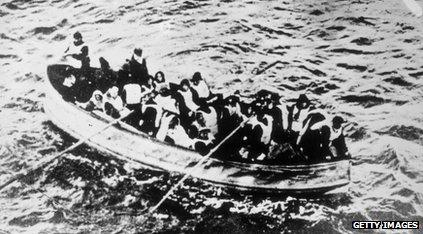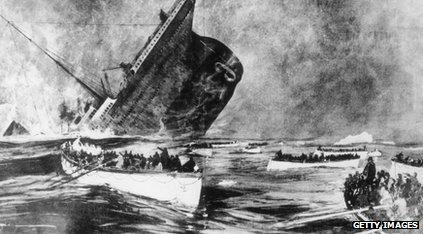How did the Titanic sink? Timeline of events
- Published

At 11.40pm on Sunday 14 April 1912, almost 100 years ago, the Titanic was just four days into its first voyage when it struck an iceberg. But how long did it take for the ocean liner to sink?
11.40pm - Titanic hits iceberg
Within minutes of hitting the iceberg the boat begins to take on thousands of tonnes of sea water through holes in its hull. The man that designed the ship, Thomas Andrews, is on board and goes to look at the damage. He tells the captain that the ship is going to sink.

12.30am, 15 April 1912 - Lifeboats are lowered
The captain, Edward J Smith, orders the lifeboats to be lowered. After ten minutes passengers start leaving the ship, with women and children taking the first spots. There are enough spaces for 1000 passengers, but some of the boats are sent off half-full.
2.10am - Ship's lights go out
The Titanic's bow, the front of the boat, is now completely underwater causing the back of the boat to lift up. 18 out of 20 of the lifeboats have been lowered and all the lights on board finally go out.

2.17am - Titanic breaks in two
The back of the boat gets pushed further out of the water. The ship's hull isn't strong enough to withstand the pressure and snaps in two.
2.19am - Bow begins to sink
The front of the boat disappears beneath the surface of the ocean, the back half of the Titanic soon following afterwards.
2.24am - Titanic reaches the bottom of the ocean
The front half of the ship reaches the bottom first. Two minutes later, the back half of the Titanic joins it on the floor of the Atlantic. The wreck of the ship is still there today.
